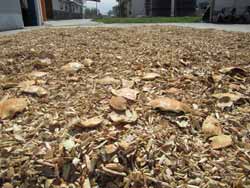Crustacean shells as a raw material for chemicals

Crustacean shells are to be converted into valuable raw material for chemical products. © Biotech Surindo /Fraunhofer IGB<br>
Shellfish, crabs and shrimps are highly valued culinary delicacies. Every year more than 750,000 tonnes of shells of these crustaceans land on the waste in the EU alone. Theoretically the shells could also be valorized. They contain chitin, a biopolymer also occurring in insects and fungi, that consists of nitrogenous sugar molecules strung together in a polymer chain. In Asia, for example, the polymer chitosan is already produced from shrimp shells. This is used to make filters or foils, and also wound dressings. However, the shells of the European crustaceans contain more lime, so processing them to obtain chitosan is not economical.
In the EU-funded ChiBio Project researchers led by the Straubing Project Group BioCat of the Fraunhofer Institute for Interfacial Engineering and Biotechnology IGB want to develop new methods of utilizing the shells that result in large quantities of waste, in order to use them here in Europe as a raw material for chemicals and new materials. The consortium comprising research and industrial partners from Norway, Austria, the Czech Republic, Ireland as well as Tunisia and Indonesia is focusing on an integrated approach. “In the manner of a biorefinery we want to develop or optimize various material and energetic uses for the waste material “crustacean shells”– and thus to utilize the residual material as efficiently and completely as possible,” explains Professor Volker Sieber, Coordinator of ChiBio and head of the BioCat Project Group in Straubing.
First of all the remaining crab meat has to be removed from the shells. “We want to separate these biomass residues, which consist of proteins and fats, in such a way that we are able to ferment them directly and use them for energetic purposes,” says Dr. Lars Wiemann, ChiBio project manager in Straubing. The purified chitin can then be split into its monomeric components, the nitrogenous sugar glucosamine, using enzymes or microorganisms. At the Fraunhofer IGB chitinases have already been isolated from bacteria that catalyze this splitting process. “It will be a great challenge to convert glucosamine into such basic components – or platform chemicals, from which chemists can produce various new, bio-based polymers,” says Dr. Wiemann. So that individual monomers can be linked to form a polymer, these require at least two functional groups that can be combined catalytically. “Here we aim to combine chemical steps with biotechnological processes,” adds Professor Sieber. The intention is to ferment all the bio-based by-products generated in the process chain together with the initially separated proteins and fats to produce biogas as a regenerative energy carrier.
The EU Research Proposal “ChiBio – Development of an Integrated Biorefinery for Processing Chitin-rich Biowaste to Specialty and Fine Chemicals” was awarded 14 out of 15 possible points – the best result in the topic “Novel Biotechnological Approaches for Transforming Industrial and/or Municipal Biowaste into Bioproducts – SICA”. The funds of 3 million euros are being made available from November 2011 for the three-year duration of the project. Regional partners are Professor Thomas Brück’s “Industrial Biocatalysis” Working Group at the TU München in Garching and Süd-Chemie AG in Moosburg from Bavaria, both Germany, as well as the Czech company Apronex and the Upper Austrian Energy Institute at the Johannes Kepler Universität Linz GmbH. Further participants are Letterkenny Institute of Technology (Letterkenny, Ireland), the Agricultural University of Norway (Oslo, Norway), Institut National des Sciences et Technologies de la Mer (Karthago, Tunisia), Earagail Eisc Teoranta (Carrick, Ireland), Evonik Industries AG (Essen, Germany) and Biotech Surindo PT (Cirebon, Indonesia).
The Project Group BioCat is part of the Straubing Center of Science at the Center of Excellence for Renewable Resources and attached to the Fraunhofer Institute for Interfacial Engineering and Biotechnology IGB in Stuttgart, which is directed by Professor Thomas Hirth. The Project Group is led by Professor Volker Sieber, who holds the Chair for the Chemistry of Biogenic Resources at the TU München.
The research project ChiBio receives funding from the European Union’s Seventh Framework Programme (FP7/2007-2013) under Grant Agreement no 289284.
Contact:
Fraunhofer IGB
Project Group BioCat
Schulgasse 16
94315 Straubing,Germany
Dr. Lars Wiemann
Phone +49 9421 187-353
lars.wiemann@igb.fraunhofer.de
Media Contact
More Information:
http://www.igb.fraunhofer.de/en/press-media/press-releases/chibio.htmlAll latest news from the category: Life Sciences and Chemistry
Articles and reports from the Life Sciences and chemistry area deal with applied and basic research into modern biology, chemistry and human medicine.
Valuable information can be found on a range of life sciences fields including bacteriology, biochemistry, bionics, bioinformatics, biophysics, biotechnology, genetics, geobotany, human biology, marine biology, microbiology, molecular biology, cellular biology, zoology, bioinorganic chemistry, microchemistry and environmental chemistry.
Newest articles

Combatting disruptive ‘noise’ in quantum communication
In a significant milestone for quantum communication technology, an experiment has demonstrated how networks can be leveraged to combat disruptive ‘noise’ in quantum communications. The international effort led by researchers…

Stretchable quantum dot display
Intrinsically stretchable quantum dot-based light-emitting diodes achieved record-breaking performance. A team of South Korean scientists led by Professor KIM Dae-Hyeong of the Center for Nanoparticle Research within the Institute for…

Internet can achieve quantum speed with light saved as sound
Researchers at the University of Copenhagen’s Niels Bohr Institute have developed a new way to create quantum memory: A small drum can store data sent with light in its sonic…





















